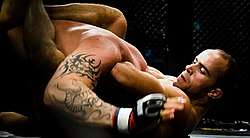Vale Tudo
Vale Tudo (Portuguese pronunciation: [ˈvali ˈtudu]; English: Everything Goes) is an unarmed, full-contact combat sport with relatively few rules. It became popular in Brazil during the 20th century.[1] It uses techniques from many martial arts.
 Rafael Silva locks Mika Ilmén in a guillotine choke during a Vale Tudo match in 2005 | |
| Also known as | no holds barred (NHB), anything goes |
|---|---|
| Focus | Hybrid |
| Hardness | Full contact |
| Country of origin | |
| Creator | Various |
| Parenthood | Luta Livre, Brazilian Jiu-Jitsu, Muay Thai, Boxing, Capoeira, Judo, Sambo, Sanda, Taekwondo, Wrestling |
| Olympic sport | No |
History
1920s to 1980s
Fighting sideshows called vale tudo became popular in Brazilian circuses during the 1920s.[2] Examples of such bouts were described in the Japanese-American Courier on October 4, 1928:[3]
One report from Brasil declares that Jiu Jitsu is truly an art and that in an interesting exhibition in the side tent to the big circus a Bahian of monstrous dimensions met his waterloo at the hands of a diminutive Japanese wrestler. The man was an expert at Capoeira, an old South American style of fighting, but after putting the Japanese on his back and trying to kick his head ... the little oriental by the use of a Jiu Jitsu hold threw the Bahian and after a short struggle he was found sitting on the silent frame of the massive opponent.
However, this circus term did not enter popular use until 1959–1960, when it was used to describe the style-versus-style bouts featured in a Rio television show called Heróis do Ringue ("Heroes of the Ring"). The matchmakers and hosts of the show included members of the Gracie family, including Carlson Gracie and Carley Gracie. The participants were all legitimate practitioners of their styles.
One night during the show, João Alberto Barreto (later a referee for UFC 1) was competing against a man trained in Luta Livre. Barreto caught his opponent in an armbar and the man refused to submit. Barreto broke the man's arm. Consequently, the show was canceled and soon replaced by a Professional Wrestling show called Telecatch.
From 1960 onwards, Vale Tudo remained mostly an underground subculture, with most fights taking place in martial arts dojos or small gymnasiums. The Vale Tudo subculture was based in Rio de Janeiro, but many fights took place in the northern region, the southern region and the Bahia state, where Capoeira is prevalent. The scene in Rio de Janeiro focused mainly on the intense rivalry between Brazilian Jiu-Jitsu and Luta Livre. Fights in the other regions featured more diverse martial arts competing in the events.
1990s to present
In the 1970s, Rorion Gracie of the famous Gracie family emigrated to the United States and introduced Vale Tudo to a new market when he helped found the Ultimate Fighting Championship (UFC) in 1993.[4] Some of the noteworthy promotions of this time include Desafio, Universal Vale Tudo Fighting and Brazilian Vale Tudo Fighting in Brazil and various Shooto sanctioned vale tudo events in Japan, the most important of which was Vale Tudo Japan. However, the premier organizations of the 1990s were World Vale Tudo Championship (WVC) and the International Vale Tudo Championship (IVC), which featured prominently throughout the 1990s as they were also televised on Brazilian TV and pay-per-view.
The WVC and IVC were based in the Brazilian financial capital of São Paulo and launched the careers of many of today's MMA stars. However, after the state of São Paulo prohibited Vale Tudo from being a sanctioned sport, both promotions went into decline and have not staged an event since 2002.
Beginning in the early 2000s, newer promotions such as Jungle Fight and Bitetti Combat abandoned traditional Vale Tudo rules in favor of the safer mixed martial arts "Unified" rules. However, some promotions continued the use of traditional rules, most notably Meca World Vale Tudo and Rio Heroes.
Today, Vale Tudo events are still taking place in great numbers around Brazil. However, due to the violent and bloody nature of the sport these underground events sometimes cause controversy in the media. Critics of the sport argue that Vale Tudo shows should all adopt the MMA "Unified" ruleset created in the United States by Athletic Commissions, and used by various other countries such as Canada and England. On the other hand, supporters of Vale Tudo criticize the Unified Rules, pointing out that there is no medical proof that the Unified Rules are safer, no contestant has ever been killed or permanently disabled while fighting under traditional rules, the Unified Rules were created not for safety, but to ban techniques that commissioners saw as "uncivilised" (such as the soccer kick and headbutt), that the Unified Rules set is not used in Japanese, Russian, Singaporean and Thai promotions, and so on. Proponents also counter that the style of mixed martial arts fighting created by the Unified Rules is now so different from traditional Vale Tudo that it should be treated as an entirely different sport, just as kickboxing is considered different from Muay Thai.
References
- About European Vale Tudo Archived 2006-04-28 at the Wayback Machine. www.europeanvaletudo.com. URL last accessed on April 28, 2006.
- Boxing booth – Boxrec Boxing Encyclopaedia. Boxrec.com. Retrieved on 2012-01-08.
- The original reference was probably "Jiu Jitsu", Time, September 24, 1928. Archived from the original on October 15, 2007 on the Wayback Machine.
- T.P. Grant, April 12, 2011 History of Jiu-Jitsu: Coming to America and the Birth of the UFC. Bleacher Report. Retrieved on 2012-01-08.
External links
- The influence of Jiu Jitsu in Vale Tudo
- Vale Tudo Statistics
- Vale Tudo Project (2009) on IMDb